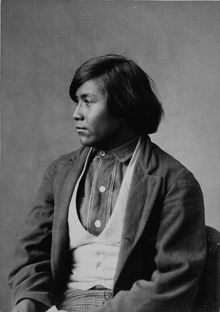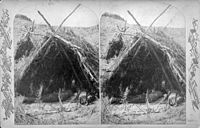

Mojave appears spelled in many ways. "The tribal name has been spelled with over 50 variations, such as Hamock avi, Amacava, A-mac-ha ves, A-moc-ha-ve, Jamajabs, and Hamakhav. The resulting incorrect assumed meanings can be partly traced to a translation error in Frederick W. Hodge's 1917 Handbook of the American Indians North of Mexico, which incorrectly defined it, 'Mohave (from hamock, three, avi, mountain).' According to this source, the name refers to the picturesque mountain peaks called The Needles, located near the Colorado River a few miles south of the city of Needles, California. The Mojave call these peaks Huqueamp avi, which means 'where the battle took place,' referring to the battle in which the God-son, Mastamho, slew the sea serpent."... W ![]() Mojave comes from two Indian words, "aha" meaning water, and "macav", meaning alongside. The historic Mojave were known as the Pipa Aha Macav--the people by the water.
Mojave comes from two Indian words, "aha" meaning water, and "macav", meaning alongside. The historic Mojave were known as the Pipa Aha Macav--the people by the water.
The Mojave people are indigenous to the Colorado River in the Mojave Desert. When the Mojave Indian Reservation was formed it included a number of states including California, Arizona and Nevada. The Colorado River Indian Reservation also included two states, California and Arizona, as well several different Indian Tribes: Chemehuevi, Hopi, and Navajo peoples. These two reservations were established in 1865 and 1870, respectively.
The Mojave language was unwritten in precolonial times and much of their history was handed down by word of mouth through stories and songs. The Mojave language is from the W Yuman Family ![]() spoken by a number of different tribes from Arizona, California and Mexico. It is known as the Hokan family. Some linguists have proposed a distant relationship between the Hokan, Muskogean and Siouan languages. Follow this link for the Mojave Tribe: History to 1860.
spoken by a number of different tribes from Arizona, California and Mexico. It is known as the Hokan family. Some linguists have proposed a distant relationship between the Hokan, Muskogean and Siouan languages. Follow this link for the Mojave Tribe: History to 1860. ![]() and this link for the History and Culture: Mojave Desert/1776-1997.
and this link for the History and Culture: Mojave Desert/1776-1997. ![]()
 Agriculture, fishing, trapping and trading were part of everyday Mojave life. They developed complex irrigation systems to grow a variety of crops including beans, corn, muskmelons, watermelons, crude wheat, cotton and pumpkins. They were tenacious traders. Their trade extended into Arizona and New Mexico. They traded with the Hope and Pueblo tribes. Their territory went as far as the coastal cities of Santa Barbara, Ventura and San Gabriel. Their networking extended as far north as Bakersfield. "A branch of the Mojave Indian Trail later became part of the Old Spanish Trail and still later part of the Salt Lake City-Los Angeles road of '49er' fame. ..." The Institution of Slavery
Agriculture, fishing, trapping and trading were part of everyday Mojave life. They developed complex irrigation systems to grow a variety of crops including beans, corn, muskmelons, watermelons, crude wheat, cotton and pumpkins. They were tenacious traders. Their trade extended into Arizona and New Mexico. They traded with the Hope and Pueblo tribes. Their territory went as far as the coastal cities of Santa Barbara, Ventura and San Gabriel. Their networking extended as far north as Bakersfield. "A branch of the Mojave Indian Trail later became part of the Old Spanish Trail and still later part of the Salt Lake City-Los Angeles road of '49er' fame. ..." The Institution of Slavery ![]() They lived in W "wikiups" (aka wigwam or wetu) constructed from logs and brush. The men wore very little clothing. The women often wore animal skins. The Mojave also tattooed themselves with an ink made from a cactus. They also tattooed their slaves with special markings on the chin. Slave trade was practiced by the Mojave Tribe.
They lived in W "wikiups" (aka wigwam or wetu) constructed from logs and brush. The men wore very little clothing. The women often wore animal skins. The Mojave also tattooed themselves with an ink made from a cactus. They also tattooed their slaves with special markings on the chin. Slave trade was practiced by the Mojave Tribe.
"...The American Southwest had a history of slavery (and some unique features of human bondage) during the Indian, Spanish, Mexican, and American periods. An important area and link in the slave trading in the southwest was the Mojave Desert with its ancient Mojave Indian Trail..., a route that actually stretched beyond the confines of the Mojave Desert itself. It went from east of the Colorado River to the Mojave River and across the San Bernardino Mountains to the Pacific Ocean." The Institution of Slavery. ![]()
For More Information:
History - Spanish/Mexican